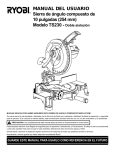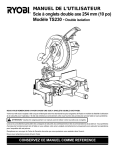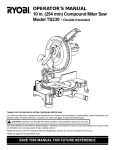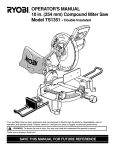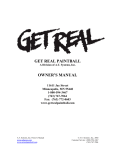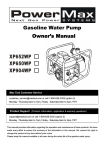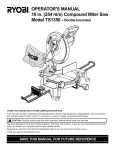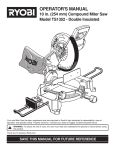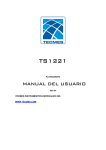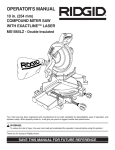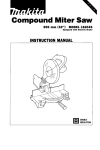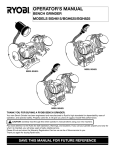Download Ryobi TS1300 Operator`s manual
Transcript
OPERATOR'S MANUAL 10 in. (254 mm) Miter Saw Model TS1300 - Double Insulated GER DANHAN DS AWAY 0 15 30 45 KEEP DE FROM BLA 15 0 NOTE: Miter Saw shown includes all available Accessories. These Accessories, which include dust bag, table extensions, stop block and work clamp, may be optional on some models. THANK YOU FOR BUYING A RYOBI MITER SAW. Your new saw has been engineered and manufactured to Ryobi's high standards for dependability, ease of operation, and operator safety. Properly cared for, it will give you years of rugged, trouble-free performance. CAUTION: Carefully read through this entire operator's manual before using your new saw. Pay close attention to the Rules for Safe Operation, Warnings, and Cautions. If you use your saw properly and only for what it is intended, you will enjoy years of safe, reliable service. Please fill out and return the Warranty Registration Card so we can be of future service to you. Thank you again for buying Ryobi tools. SAVE THIS MANUAL FOR FUTURE REFERENCE TABLE OF CONTENTS Table Of Contents ........................................................... 2 Safety and International Symbols ................................. 2 Rules For Safe Operation ............................................ 3-6 Additional Rules For Safe Operation For Miter Saws ................................................................... 6 Product Specifications ................................................... 7 Glossary Of Terms For Woodworking .......................... 7 Unpacking And Checking Contents .............................. 8 Loose Parts List ........................................................... 8 Features ...................................................................... 9-11 A. Know Your Miter Saw .............................................. 9 14 Amp Motor .......................................................... 9 10 in. (254 mm) Carbide Tipped Blade ................... 9 Cutting Capacities ................................................... 9 Carrying Handle ...................................................... 9 Miter Lock Handle ................................................. 10 Lock-Off Lever ....................................................... 10 Spindle Lock Button .............................................. 10 Trigger Lock .......................................................... 10 Positive Stops On Miter Table ............................... 10 Electric Brake ........................................................ 10 Fence .................................................................... 10 Self-Retracting Lower Blade Guard ....................... 10 Work Clamp ........................................................... 10 Mounting Holes ..................................................... 11 B. Optional Accessories ............................................. 11 C. Electrical Connection ............................................. 11 Assembly .................................................................. 12-14 A. Miter Lock Handle ................................................. 12 B. Work Clamp (Optional) .......................................... 12 C. Dust Guide ............................................................ 12 D. To Install Blade ................................................. 12-13 E. Dust Bag (Optional) ............................................... 14 F. Table Extensions (Optional) .................................. 14 G. Stop Block (Optional) ............................................ 14 Adjustments ............................................................. 14-17 A. Squaring The Miter Table To The Fence .............. 15 B. Squaring The Saw Blade To The Fence ............... 16 C. Pivot Adjustments .................................................. 17 Travel Pivot Adjustment ........................................ 17 D. Depth Stop ............................................................ 17 E. Depth Stop Adjustments ........................................ 17 Operation .................................................................. 17-20 A. Applications ........................................................... 17 B. Cutting With Your Miter saw .................................. 18 C. Crosscutting .......................................................... 18 To Crosscut With Your Miter saw .......................... 18 D. Support Long Workpieces ..................................... 19 E. Cutting Warped Material ........................................ 20 F. Clamping Wide Workpieces .................................. 20 Maintenance ............................................................. 21-22 A. General .................................................................. 21 B. Lubrication ............................................................. 21 C. Extension Cords .................................................... 21 D. Brush Replacement ............................................... 22 Troubleshooting ............................................................ 23 Exploded Views and Parts List ............................... 24-27 Parts Ordering / Service ............................................... 28 SAFETY AND INTERNATIONAL SYMBOLS This operator's manual describes safety and international symbols and pictographs that may appear on this product. Read the operator's manual for complete safety, assembly, operating and maintenance and repair information. SYMBOL MEANING • NO HANDS SYMBOL Failure to keep your hands away from the blade will result in serious personal injury. • READ OPERATOR'S MANUAL Failure to follow operating instructions and safety precautions in operator's manual can result in serious injury. Read operator's manual before starting or operating this unit. Page 2 RULES FOR SAFE OPERATION The purpose of safety symbols is to attract your attention to possible dangers. The safety symbols, and the explanations with them, deserve your careful attention and understanding. The safety warnings do not by themselves eliminate any danger. The instructions or warnings they give are not substitutes for proper accident prevention measures. SYMBOL MEANING SAFETY ALERT SYMBOL: Indicates danger, warning, or caution. May be used in conjunction with other symbols or pictographs. DANGER: Failure to obey a safety warning will result in serious injury to yourself or to others. Always follow the safety precautions to reduce the risk of fire, electric shock and personal injury. WARNING: Failure to obey a safety warning can result in serious injury to yourself or to others. Always follow the safety precautions to reduce the risk of fire, electric shock and personal injury. CAUTION: Failure to obey a safety warning may result in property damage or personal injury to yourself or to others. Always follow the safety precautions to reduce the risk of fire, electric shock and personal injury. NOTE: Advises you of information or instructions vital to the operation or maintenance of the equipment. DOUBLE INSULATION IMPORTANT Double insulation is a concept in safety, in electric power tools, which eliminates the need for the usual three-wire grounded power cord. All exposed metal parts are isolated from internal metal motor components with protecting insulation. Double insulated tools do not need to be grounded. Servicing requires extreme care and knowledge and should be performed only by a qualified service technician. For service we suggest you return the tool to your nearest RYOBI AUTHORIZED SERVICE CENTER for repair. When servicing, use only identical Ryobi replacement parts. WARNING: WARNING: The double insulated system is intended to protect the user from shock resulting from a break in the tool's internal wiring. Observe all normal safety precautions related to avoiding electrical shock. Do not attempt to operate this tool until you have read thoroughly and understand completely all instructions, safety rules, etc. contained in this manual. Failure to comply can result in accidents involving fire, electric shock, or serious personal injury. Save this operator's manual and review frequently for continuing safe operation and instructing others who may use this tool. Page 3 RULES FOR SAFE OPERATION Safe operation of this power tool requires that you read and understand this operator's manual and all labels affixed to the tool. Safety is a combination of common sense, staying alert, and knowing how your miter saw works. READ ALL INSTRUCTIONS 1. KNOW YOUR POWER TOOL. Read the operator's manual carefully. Learn the saw's applications and limitations as well as the specific potential hazards related to this tool. 2. GUARD AGAINST ELECTRICAL SHOCK BY PREVENTING BODY CONTACT WITH GROUNDED SURFACES. For example; pipes, radiators, ranges, refrigerator enclosures. 3. KEEP GUARDS IN PLACE and in good working order. 4. KEEP THE WORK AREA CLEAN. Cluttered work areas and work benches invite accidents. DO NOT leave tools or pieces of wood on the saw while it is in operation. 5. DO NOT USE IN DANGEROUS ENVIRONMENTS. Do not use power tools near gasoline or other flammable liquids, in damp or wet locations, or expose them to rain. Keep the work area well lit. 6. KEEP CHILDREN AND VISITORS AWAY. All visitors should wear safety glasses and be kept a safe distance from work area. Do not let visitors contact tool or extension cord while operating. 7. MAKE WORKSHOP CHILD-PROOF with padlocks and master switches, or by removing starter keys. 8. DO NOT FORCE THE TOOL. It will do the job better and safer at the rate for which it was designed. 9. USE THE RIGHT TOOL. Do not force the tool or attachment to do a job it was not designed for. Don't use it for a purpose not intended. 10. DRESS PROPERLY. Do not wear loose clothing, gloves, neckties, rings, bracelets, or other jewelry. They can get caught and draw you into moving parts. Rubber gloves and nonslip footwear are recommended when working outdoors. Also wear protective hair covering to contain long hair. 11. ALWAYS WEAR SAFETY GLASSES WITH SIDE SHIELDS. Everyday eyeglasses have only impactresistant lenses; they are NOT safety glasses. 12. PROTECT YOUR LUNGS. Wear a face or dust mask if the cutting operation is dusty. 16. MAINTAIN TOOLS WITH CARE. Keep tools sharp and clean for better and safer performance. Follow instructions for lubricating and changing accessories. 17. DISCONNECT ALL TOOLS. When not in use, before servicing, or when changing attachments, blades, bits, cutters, etc., all tools should be disconnected. 18. REMOVE ADJUSTING KEYS AND WRENCHES. Get in the habit of checking to see that hex keys and adjusting wrenches are removed from tool before turning it on. 19. AVOID ACCIDENTAL STARTING. Be sure switch is off when plugging in. 20. USE THE PROPER EXTENSION CORD. Make sure your extension cord is in good condition. When using an extension cord, be sure to use one heavy enough to carry the current your product will draw. An undersized cord will cause a drop in line voltage resulting in loss of power and overheating. A wire gage size (A.W.G.) of at least 14 is recommended for an extension cord 25 feet or less in length. If in doubt, use the next heavier gage. The smaller the gage number, the heavier the cord. 21. USE OUTDOOR EXTENSION CORDS. When tool is used outdoors, use only extension cords with approved ground connection that are intended for use outdoors and so marked. 22. KEEP BLADES CLEAN AND SHARP. Sharp blades minimize stalling and kickback. 23. KEEP HANDS AWAY FROM CUTTING AREA. Keep hands away from blades. Do not reach underneath work or around or under the blade while blade is rotating. Do not attempt to remove cut material when blade is moving. WARNING: Blades coast after turn off. 24. NEVER USE IN AN EXPLOSIVE ATMOSPHERE. Normal sparking of the motor could ignite fumes. 25. INSPECT TOOL CORDS PERIODICALLY and if damaged, have repaired at your nearest AUTHORIZED SERVICE CENTER. Stay constantly aware of cord location and keep it well away from the rotating blade. 26. INSPECT EXTENSION CORDS PERIODICALLY and replace if damaged. 13. PROTECT YOUR HEARING. Wear hearing protection during extended periods of operation. 27. KEEP TOOL DRY, CLEAN, AND FREE FROM OIL AND GREASE. Always use a clean cloth when cleaning. Never use brake fluids, gasoline, petroleum-based products, or any solvents to clean tool. 14. DO NOT ABUSE CORD. Never yank cord to disconnect it from receptacle. Keep cord from heat, oil, and sharp edges. 28. STAY ALERT AND EXERCISE CONTROL. Watch what you are doing and use common sense. Do not operate tool when you are tired. Do not rush. 15. DO NOT OVERREACH. Keep proper footing and balance at all times. Page 4 RULES FOR SAFE OPERATION 29. CHECK DAMAGED PARTS. Before further use of the tool, a guard or other part that is damaged should be carefully checked to determine that it will operate properly and perform its intended function. Check for alignment of moving parts, binding of moving parts, breakage of parts, mounting and any other conditions that may affect its operation. A guard or other part that is damaged must be properly repaired or replaced by an authorized service center to avoid risk of personal injury. 30. DO NOT USE TOOL IF SWITCH DOES NOT TURN IT ON AND OFF. Have defective switches replaced by an authorized service center. 38. NEVER LEAVE TOOL RUNNING UNATTENDED. TURN THE POWER OFF. Do not leave tool until it comes to a complete stop. 39. AVOID CUTTING NAILS. Inspect for and remove all nails from lumber before cutting. 40. NEVER TOUCH BLADE or other moving parts during use. 41. NEVER START A TOOL WHEN THE BLADE IS IN CONTACT WITH THE WORKPIECE. 31. USE THE FENCE. Always use the fence when cutting. 42. DO NOT OPERATE THIS TOOL WHILE UNDER THE INFLUENCE OF DRUGS, ALCOHOL, OR ANY MEDICATION. 32. SUPPORT LONG WORKPIECES. To minimize risk of blade pinching and kickback, always support long workpieces. 43. SECURE WORK. Use clamps or a vise to hold work when practical. It's safer than using your hand and it frees both hands to operate tool. 33. BEFORE MAKING A CUT, BE SURE ALL ADJUSTMENTS ARE SECURE. 44. REPLACEMENT PARTS. All repairs, whether electrical or mechanical, should be made at your nearest Authorized Service Center. 34. USE ONLY CORRECT BLADES. Do not use blades with incorrect size holes. Never use blade washers or blade screws that are defective or incorrect. The maximum blade capacity of your saw is 10 in. (254 mm). 35. USE RECOMMENDED ACCESSORIES. The use of improper accessories may cause risk of injury. 36. NEVER STAND ON TOOL. Serious injury could occur if the tool is tipped or if the blade is unintentionally contacted. 37. POLARIZED PLUGS. To reduce the risk of electric shock, this tool has a polarized plug (one blade is wider than the other). This plug will fit in a polarized outlet only one way. If the plug does not fit fully in the outlet, reverse the plug. If it still does not fit, contact a qualified electrician to install the proper outlet. Do not change the plug in any way. WARNING: When servicing use only identical Ryobi replacement parts. Use of any other parts may create a hazard or cause product damage. 45. SAVE THESE INSTRUCTIONS. Refer to them frequently and use them to instruct other users. If you loan someone this tool, loan them these instructions also. WARNING: WEAR YOUR SAFETY GLASSES FORESIGHT IS BETTER THAN NO SIGHT The operation of any saw can result in foreign objects being thrown into your eyes, which can result in severe eye damage. Before beginning power tool operation, always wear safety goggles or safety glasses with side shields and a full face shield when needed. We recommend Wide Vision Safety Mask for use over eyeglasses or standard safety glasses with side shields. Look for this symbol to point out important safety precautions. It means attention!!! Your safety is involved. Page 5 Additional Rules For Safe Operation For Miter Saws 1. NEVER USE A DULL SAW BLADE or one that does not have sufficient set. 2. DO NOT REMOVE THE SAW'S BLADE GUARDS. Never operate the saw with any guard or cover removed. Make sure all guards are operating properly before each use. 3. MAKE SURE THE MITER TABLE IS LOCKED IN POSITION BEFORE OPERATING YOUR SAW. Lock the miter table by securely tightening the miter lock handle. 4. NEVER PERFORM ANY OPERATION "FREEHAND". Always place the workpiece to be cut on the miter table and position it firmly against the fence as a backstop. 5. ALWAYS USE A CLAMP to secure the workpiece when possible. 6. NEVER hand hold a workpiece that is too small to be clamped. Keep hands clear of the no hands zone. 7. NEVER reach behind or under the blade and its cutting path with your hands and fingers for any reason. 8. NEVER stand or have any part of your body in line with the path of the saw blade. 9. ALLOW THE MOTOR TO COME UP TO FULL SPEED before starting a cut. 10. ALWAYS release the power switch and allow the saw blade to stop rotating before raising it out of the workpiece. 11. NEVER reach to pick up a workpiece, a piece of scrap, or anything else that is in or near the cutting path of the blade. 12. NEVER leave the miter saw unattended while connected to a power source. 13. FIRMLY CLAMP OR BOLT your miter saw to a workbench or table. The most comfortable saw table height is 39 inches or at approximately hip height. 14. AVOID AWKWARD OPERATIONS AND HAND POSITIONS where a sudden slip could cause your hand to move into the blade. ALWAYS make sure you have good balance. NEVER operate your miter saw on the floor or in a crouched position. 15. ALWAYS PROVIDE ADEQUATE ROOM AND SUPPORT for crosscutting long workpieces. 16. NEVER USE A LENGTH STOP ON THE FREE SCRAP END OF A CLAMPED WORKPIECE. NEVER hold onto or bind the free scrap end of the workpiece in any operation. If a work clamp and length stop are used together, they must both be installed on the same side of the saw table to prevent the saw from catching the loose end and kicking up. 17. DO NOT TURN THE MOTOR SWITCH ON AND OFF RAPIDLY. This could cause the saw blade to loosen and could create a hazard. Should this ever occur, stand clear and allow the saw blade to come to a complete stop. Disconnect your saw from the power supply and securely retighten the blade bolt. 18. NEVER cut more than one piece at a time. DO NOT STACK more than one workpiece on the saw table at a time. 19. IF ANY PART OF THIS MITER SAW IS MISSING or should break, bend, or fail in any way, or should any electrical component fail to perform properly, shut off the power switch, remove the miter saw plug from the power source and have damaged, missing, or failed parts replaced before resuming operation. 20. ALWAYS STAY ALERT! Do not allow familiarity (gained from frequent use of your saw) to cause a careless mistake. ALWAYS REMEMBER that a careless fraction of a second is sufficient to inflict severe injury. 21. MAKE SURE THE WORK AREA HAS AMPLE LIGHTING to see the work and that no obstructions will interfere with safe operation BEFORE performing any work using your saw. 22. ALWAYS TURN OFF SAW before disconnecting it, to avoid accidental starting when reconnecting to power supply. 23. SAVE THESE INSTRUCTIONS. Refer to them frequently and use to instruct other users. If you loan someone this tool, loan them these instructions also. WARNING: Some dust created by power sanding, sawing, grinding, drilling, and other construction activities contains chemicals known to cause cancer, birth defects or other reproductive harm. Some examples of these chemicals are: • lead from lead-based paints, • crystalline silica from bricks and cement and other masonry products, and • arsenic and chromium from chemically-treated lumber. Your risk from these exposures varies, depending on how often you do this type of work. To reduce your exposure to these chemicals: work in a well ventilated area, and work with approved safety equipment, such as those dust masks that are specially designed to filter out microscopic particles. SAVE THESE INSTRUCTIONS Page 6 PRODUCT SPECIFICATIONS Blade Diameter .................................................................................................................................. 10 in. (254 mm) Blade Arbor ........................................................................................................................................ 5/8 in. (16 mm) No Load Speed ........................................................................................................................................ 5,000 RPM Rating ................................................................................................................................ 120 Volts, 60 Hz-AC Only Input ........................................................................................................................................................ 14 Amperes Cutting Capacity For Both Flat And Vertical Cuts On Dimensional Lumber 90° Crosscut ................................................................................................................................ 2 x 4 and 4 x 4 2 x 6 (Flat only) 45° Miter ....................................................................................................................................................... 2 x 4 Net Weight ....................................................................................................................................... 29 lbs. (13.2 kg.) GLOSSARY OF TERMS FOR WOODWORKING Arbor The shaft on which a blade or cutting tool is mounted. Crosscut A cutting or shaping operation made across the grain of the workpiece. Freehand Performing a cut without using a fence, miter gage, fixture, work clamp, or other proper device to keep the workpiece from twisting during the cut. Gum A sticky, sap based residue from wood products. Miter Cut A cutting operation made with the wood at any angle other than 90 degrees to the fence. Resin A sticky, sap base substance that has hardened. Revolutions Per Minute (RPM) The number of turns completed by a spinning object in one minute. Saw Blade Path The area over, under, behind, or in front of the blade. As it applies to the workpiece, that area which will be, or has been, cut by the blade. Set The distance that the tip of the sawblade tooth is bent (or set) outward from the face of the blade. Throw-Back Throwing of a workpiece in a manner similar to a kickback. Usually associated with a cause other than the kerf closing, such as a workpiece not being against the fence, being dropped into the blade, or being placed inadvertently in contact with the blade. Through Sawing Any cutting operation where the blade extends completely through the thickness of the workpiece. Workpiece The item on which the cutting operation is being done. The surfaces of a workpiece are commonly referred to as faces, ends, and edges. No Hands Zone The area between the marked lines on the left and right side of the miter table base. This zone is identified by no hands zone labels placed inside the marked lines on the miter table base. The operator's hands must stay clear of this area during any operation of the saw. Page 7 UNPACKING AND CHECKING CONTENTS Your Miter Saw has been shipped completely assembled except for the blade, miter lock handle, dust guide or dust bag, work clamp, table extensions, and stop block. ■ Remove all loose parts from the carton. Separate and check with the list of Loose Parts. See Figure 1. ■ Remove the packing materials from around your saw. ■ Carefully lift saw from the carton and place it on a level work surface. Although small, this saw is heavy. To avoid back injury, get help when needed. ■ Do not discard the packing materials until you have carefully inspected the saw, identified all loose parts, and satisfactorily operated your new saw. ■ Your saw has been shipped with the saw arm locked in the down position. To release saw arm, push down on top of saw arm and pull out the lock pin. See Figure 3. ■ Lift the saw arm by the handle. Hand pressure should remain on the saw arm to prevent sudden rise upon release of the lock pin. ■ Examine all parts to make sure no breakage or damage has occurred during shipping. If any parts are damaged or missing, do not attempt to plug in the power cord and turn the switch on until the damaged or missing parts are obtained and are installed correctly. Contact your nearest Ryobi dealer or call 1-800-525-2579 in the United States or 1-800-265-6778 in Canada for assistance if any parts are missing or damaged. WARNING: If any parts are missing do not operate your saw until the missing parts are replaced. Failure to do so could result in possible serious injury. LOOSE PARTS LIST The following items are included with your Miter Saw: ■ 10 in. (254 mm) Carbide Tipped Blade ■ Miter Lock Handle ■ Dust Guide ■ Blade Wrench ■ 5 mm Hex Key ■ 6 mm Hex Key ■ 8 mm Hex Key ■ Operator's Manual ■ Warranty Registration Some models may include one or more of the following accessories: ■ Work Clamp ■ 8 mm Work Clamp Screw ■ Dust Bag ■ Stop Block ■ Table Extensions (2) ■ Small Wing Screw (for use with stop block) ■ Large Wing Screws (2), for use with table extensions) WORK CLAMP DUST BAG MITER LOCK HANDLE 8 mm WORK CLAMP SCREW STOP BLOCK IO N TAT LARGE WING SCREWS SMALL WING SCREW RO ROTATION TABLE EXTENSIONS 5 mm HEX KEY 8 mm HEX KEY SAW BLADE INS BLADE WRENCH DUST GUIDE 6 mm HEX KEY Page 8 Fig. 1 FEATURES KNOW YOUR MITER SAW CUTTING CAPACITIES See Figure 2. Before attempting to use your saw, familiarize yourself with all operating features and safety requirements. When the miter angle (miter table) is set at 0°: Your saw will cut dimensional lumber up to a 2 x 6. It will cut dimensional lumber up to the thickness of a 4 x 4. When the miter angle (miter table) is set at 45°: Your saw will cut dimensional lumber up to a 2 x 4. WARNING: Do not allow familiarity with your miter saw to make you careless. Remember that a careless fraction of a second is sufficient to inflict severe injury. 14 AMP MOTOR Your saw has a powerful 14 amp motor with sufficient power to handle tough cutting jobs. It is made with all ball bearings, and has externally accessible brushes for ease of servicing. 10 in. (254 mm) CARBIDE TIPPED BLADE CARRYING HANDLE See Figure 3. For convenience when carrying or transporting your miter saw from one place to another, a carrying handle has been provided on top of the saw arm as shown in figure 3. To transport, turn off and unplug your saw, then lower the saw arm and lock it in the down position. Lock saw arm by depressing the lock pin. Tighten the miter lock handle. Remove the saw from the workbench or workstand. It is now ready to transport. A 10 in. (254 mm) carbide tipped saw blade is included with your miter saw. It is fine for most wood cutting operations, but for fine joinery cuts or cutting plastic, use one of the accessory blades available from your nearest Ryobi dealer. SWITCH LOCK-OFF LEVER SAW ARM UPPER BLADE GUARD DUST BAG GER DANHAN DS AWAY KEEP DE FROM BLA SWITCH TRIGGER LOWER BLADE GUARD MITER TABLE NO HANDS ZONE LABEL FENCE "NO HANDS ZONE" BOUNDARY LINE WORK CLAMP 45 MITER TABLE BASE MITER SCALE 0 15 30 STOP BLOCK 15 0 MITER LOCK PLATE TABLE EXTENSION 8 mm WORK CLAMP SCREW POSITIVE STOP (S) Page 9 CONTROL ARM MITER LOCK HANDLE Fig. 2 FEATURES MITER LOCK HANDLE CARRYING HANDLE See Figure 3. The miter lock handle securely locks your saw at desired miter angles. LOCK-OFF LEVER See Figure 4. The switch trigger is equipped with a lock-off lever to reduce the possibility of accidental starting. The lock-off lever must be slid back away from the switch trigger in order to turn saw on. Once the saw is on, the lock-off lever can be released. The spring loaded lever will spring back into the lock-off position when the switch trigger is released. SAW ARM LOCK PIN 15 0 SPINDLE LOCK BUTTON 15 See Figure 4. A spindle lock button has been provided for locking the spindle of your saw in a stationary position. Depress and hold the lock button while installing, changing, or removing blade. 30 45 MITER LOCK HANDLE TRIGGER LOCK See Figure 5. To prevent unauthorized use of your miter saw, we suggest that you disconnect it from the power supply and lock the switch in the off position. To lock the switch, install a padlock through the hole in the switch trigger. A lock with a shackle up to 13/64 in. (5 mm) diameter may be used. When the lock is installed and locked, the switch is inoperable. Store the padlock key in another location. SAW ARM LOCKED IN DOWN POSITION Fig. 3 SPINDLE LOCK BUTTON LOCK-OFF LEVER POSITIVE STOPS ON MITER TABLE Positive stops have been provided at 0°, 15°, 22-1/2°, 30°, and 45°. The 15°, 22-1/2°, 30°, and 45° positive stops have been provided on both the left and right side of the miter table. SWITCH TRIGGER ELECTRIC BRAKE An electric brake has been provided to quickly stop blade rotation after the switch is released. FENCE Fig. 4 The fence on your miter saw has been provided as a support to hold your workpiece securely against when making all cuts. SELF-RETRACTING LOWER BLADE GUARD The lower blade guard is made of shock-resistant, seethrough plastic that provides protection from each side of the blade. It retracts over the upper blade guard as the saw is lowered into the workpiece. SWITCH TRIGGER WORK CLAMP (Optional) An optional work clamp has been provided with your saw. It provides one means of clamping the workpiece to the fence. Clamping secures the work and prevents the workpiece from creeping toward the saw blade. This is very helpful when cutting miters. PADLOCK Fig. 5 Page 10 FEATURES MOUNTING HOLES See Figure 6. Your miter saw should be mounted to a firm supporting surface such as workbench. Four bolt holes have been provided in the saw base for this purpose. Each of the four mounting holes should be bolted securely using 3/8 in. (10 mm) machine bolts, lock washers, and hex nuts (not included). Bolts should be of sufficient length to accommodate the saw base, lock washers, hex nuts, and the thickness of the workbench. Tighten all four bolts securely. The hole pattern, shown in figure 6, is for an 18 in. (457 mm) x 24 in. (610 mm) workbench. Carefully check the workbench after mounting to make sure that no movement can occur during use. If any tipping, sliding, or walking is noted, secure the workbench to the floor before operating. OPTIONAL ACCESSORIES Optional accessories, provided on some models, are available for use with your saw. They include table extensions, a stop block, work clamp, and dust bag. Table extensions increase the work surface to 36 in. wide, providing support for cutting long workpieces. The stop block provides a stop for making repetitive cuts to same length. It can be installed on either side of saw base. The work clamp provides a means for clamping workpiece securely against the fence when making a cut. Standard "C" clamps can also be used for this purpose. The dust bag catches sawdust, helping keep work area cleaner. 7-1/8" 7-1/8” These accessories are also available from your Ryobi dealer. For the location of a distributor near you, call 1-800-5252579 in the United States or 1-800-265-6778 in Canada. ELECTRICAL CONNECTION Your saw has a precision built electric motor. It should be connected to a power supply that is 120 volts, 60 Hz, AC only (normal household current). Do not operate this tool on direct current (DC). A substantial voltage drop will cause a loss of power and the motor will overheat. If your tool does not operate when plugged into an outlet, double-check the power supply. WARNING: The operation of any saw can result in foreign objects being thrown into your eyes, which can result in severe eye damage. Before starting power tool operation, always wear safety goggles or safety glasses with side shields and a full face shield when needed. We recommend wide vision safety mask for use over eyeglasses or standard safety glasses with side shields. WARNING: Do not attempt to modify this tool or create accessories not recommended for use with this tool. Any such alteration or modification is misuse and could result in a hazardous condition leading to possible serious personal injury. 9-7/8" 9-7/8” 3-3/8” 3-3/8" 4-1/8" 4-1/8” 18” 18" 9-3/4" 9-3/4” 7/16” DIA. DIA. HOLE HOLE 7/16" 4-1/8” 4-1/8" 3-3/4” 3-3/4" 16-1/2” 16-1/2" 24” 24" Page 11 Fig. 6 ASSEMBLY WARNING: 15 To prevent accidental starting that could cause possible serious personal injury, assemble all parts, make sure all adjustments are complete, and make sure all fasteners are secure before connecting saw to power supply. Saw should never be connected to power supply when you are assembling parts, making adjustments, installing or removing blades, or when not in use. 0 TO LOOSEN 15 30 45 As mentioned previously your saw has been factory assembled and adjusted. The miter lock handle, work clamp, dust guide or dust bag, table extensions, stop block, and blade are the only parts that have to be installed. TO TIGHTEN CONTROL ARM MITER LOCK HANDLE MITER TABLE MITER LOCK HANDLE See Figure 7. To install the miter lock handle, place the threaded stud on the end of the miter lock handle into the threaded hole in the control arm under miter table. Turn clockwise to tighten. Fig. 7 WORK CLAMP (Optional) 0 15 30 45 See Figure 8. To install optional work clamp, part number 982021-001, place the shaft of the clamp in either hole in front of the miter table base. Thread the 8 mm work clamp screw provided into the side of the base and tighten it to secure the clamp in position. Rotate the knob on the clamp to move it in or out as needed. 15 0 WARNING: When using the work clamp with the stop block, install the clamp on the stop block side of the blade. This will eliminate the possibility of the saw catching the loose end and kicking up. Failure to heed this warning can result in serious personal injury. WORK CLAMP MITER TABLE BASE 8 mm WORK CLAMP SCREW DUST GUIDE See Figure 9. To install the dust guide, place the end marked INSERT over the exhaust port in the upper blade guard. Turn the guide so that the open end is facing down. Fig. 8 DUST GUIDE UPPER BLADE GUARD EXHAUST PORT TO INSTALL BLADE See Figures 10, 11, and 12. WARNING: 0 Page 12 15 A 10 in. (254 mm) blade is the maximum blade capacity of your saw. Never use a blade that is too thick to allow outer blade washer to engage with the flats on the spindle. Larger blades will come in contact with the blade guards, while thicker blades will prevent the blade bolt from securing the blade on the spindle. Either of these situations could result in a serious accident and can cause serious personal injury. 15 30 45 Fig. 9 ASSEMBLY ■ Unplug your saw. LOWER BLADE GUARD WARNING: NOTCH Failure to unplug your saw could result in accidental starting causing possible serious personal injury. LOWER BLADE GUARD BRACKET IO N TAT RO ■ Push down on the saw arm and pull out the lock pin to release saw arm. Raise saw arm to its full raised position. Be cautious, saw arm is spring loaded to raise. ■ Loosen the phillips screw on the blade bolt cover until blade bolt cover can be raised. See Figure 11. ■ Gently raise the lower blade guard bracket, releasing lower blade guard from notch so that it can be rotated up. See Figure 10. ■ Rotate the lower blade guard and blade bolt cover up and back to expose the blade bolt. ■ Depress the spindle lock button and rotate the blade bolt until the spindle locks. See Figure 12. ■ Using the blade wrench provided, loosen and remove the blade bolt. NOTE: The blade bolt has left hand threads. Turn blade bolt clockwise to loosen. ■ Remove outer blade washer. Do not remove inner blade washer. ■ Wipe a drop of oil onto inner blade washer and outer blade washer where they contact the blade. Fig. 10 LOWER BLADE GUARD PHILLIPS SCREW BLADE BOLT COVER WARNING: FLAT (S) ON SPINDLE ■ Fit saw blade inside lower blade guard and onto spindle. The blade teeth point downward at the front of saw as shown in figure 11. INNER BLADE WASHER WITH DOUBLE "D" FLATS ON If inner blade washer has been removed, replace it before placing blade on spindle. Failure to do so could cause an accident since blade will not tighten properly. TI TA TATION RO RO BLADE TO LOOSEN TO TIGHTEN BLADE BOLT OUTER BLADE WASHER WITH DOUBLE "D" FLATS Fig. 11 CAUTION: Always install the blade with the blade teeth and the arrow printed on the side of the blade pointing down at the front of the saw. The direction of blade rotation is also stamped with an arrow on the upper blade guard. ■ Replace outer blade washer. The double "D" flats on the blade washers align with the flats on the spindle. ■ Depress spindle lock button and replace blade bolt. NOTE: The blade bolt has left hand threads. Turn blade bolt counterclockwise to tighten. ■ Tighten blade bolt securely. ■ Remove the blade wrench and store it in a safe place for future use. SPINDLE LOCK BUTTON Page 13 Fig. 12 ASSEMBLY ■ Replace the lower blade guard and blade bolt cover. ■ Retighten phillips screw securing blade bolt cover. WARNING: WARNING: Make sure the spindle lock button is not engaged before reconnecting saw into power source. Never engage spindle lock button when blade is rotating. DUST BAG (Optional) An optional dust bag, part number 4090001, is available for use on your miter saw. It fits over the exhaust port on the upper blade guard. To install it, remove dust guide from exhaust port. Then, squeeze the two metal clips to open the mouth of the bag and slide it on the exhaust port. Release the clips. The metal ring in the bag should lock in between the grooves on the exhaust port. To remove the dust bag for emptying, simply reverse the above procedure. TABLE EXTENSIONS (Optional) To install optional table extensions, part number 982022-001, insert the ends of extensions into the holes in the sides of the base. Adjust the extensions to the desired length. To secure them in place, screw the two thumb screws provided into the holes in the front of the base and tighten them securely. Before connecting saw to power source, make sure the saw blade or blade guard will not hit the work clamp or table extensions when cutting 35° to 45° angles. STOP BLOCK (Optional) The optional stop block is included with the Table extensions and is useful as a stop for making repetitive cuts to the same length. It can be installed on either side of the saw base: ■ Loosen the thumb screw and adjust the stop block the desired distance from the blade for the cut to be made. For accurate placement of the stop block, measure the distance from the teeth set on the blade to the stop block. ■ Tighten thumb screw securely. ■ Make a test cut in scrap material and measure the length of the workpiece. ■ Make any necessary adjustments. WARNING: When using the work clamp with the stop block, install the clamp on the same side as the stop block. This will eliminate the possibility of trapping the workpiece, resulting in the saw blade and workpiece kicking up. Failure to heed this warning can result in serious personal injury. WARNING: Always make sure your miter saw is securely mounted to a workbench or an appropriate workstand. Failure to do so could result in an accident resulting in possible serious personal injury. ADJUSTMENTS Your Ryobi miter saw has been adjusted at the factory for making very accurate cuts. However, some of the components might have been jarred out of alignment during shipping. Also, over a period of time, readjustment will probably become necessary due to wear. After unpacking your saw, check the following adjustments before you begin using saw. Make any readjustments that are necessary and periodically check the parts alignment to make sure that your saw is cutting accurately. NOTE: Many of the illustrations in this manual show only portions of your miter saw. This is intentional so that we can clearly show points being made in the illustrations. Never operate your saw without all guards securely in place and in good operating condition. WARNING: Your saw should never be connected to power supply when you are assembling parts, making adjustments, installing or removing blades, or when not in use. Disconnecting your saw will prevent accidental starting that could cause serious injury. Page 14 ADJUSTMENTS SQUARING THE MITER TABLE TO THE FENCE See Figures 13 - 16. ■ Unplug your saw. FENCE MITER TABLE WARNING: Failure to unplug your saw could result in accidental starting causing possible serious personal injury. 45 ˚ ˚ 45 30 30˚ ˚ ■ Push down on the saw arm and pull out the lock pin to release the saw arm. See Figure 3. ■ Raise saw arm to its full raised position. ■ Loosen the miter lock handle approximately one-half turn. ■ Depress the miter lock plate and rotate the miter table until the pointer on the control arm is positioned in the positive stop at 0°. ■ Release the miter lock plate and securely tighten the miter lock handle. ■ Lay a framing square flat on the miter table. Place one leg of the square against the fence. Place the other leg of the square beside the blade slot in the miter table. The edge of the square and the blade slot in the miter table should be parallel as shown in figure 13. ■ If the edge of the framing square and the blade slot in the miter table are not parallel as shown in figures 14 and 15, adjustments are needed. ■ Using a 6 mm hex key provided, loosen the socket head screws securing the fence. See Figure 16. Adjust the fence left or right until the framing square and blade slot are parallel. ■ Retighten the screws securely and recheck the fenceto-table alignment. 15 15˚ 0˚ BLADE SLOT FRAMING SQUARE VIEW OF MITER TABLE NOT SQUARE WITH FENCE, ADJUSTMENTS ARE REQUIRED FENCE MITER TABLE 45 ˚ ˚ 45 30 30˚ ˚ 15 15˚ 0˚ BLADE SLOT FRAMING SQUARE VIEW OF MITER TABLE NOT SQUARE WITH FENCE, ADJUSTMENTS ARE REQUIRED Fig. 15 FENCE MITER TABLE 6 mm SOCKET HEAD SCREW(S) 45 Fig. 14 6 mm SOCKET HEAD SCREW(S) ˚ ˚ 45 30 30˚ ˚ 15 0˚ 15˚ ° 45 45 ° BLADE SLOT FRAMING SQUARE MITER LOCK PLATE MITER LOCK HANDLE CORRECT VIEW OF MITER TABLE SQUARE WITH FENCE 30° 30° 15° 0° 15° FENCE Fig. 13 Fig. 16 Page 15 ADJUSTMENTS SQUARING THE SAW BLADE TO THE FENCE See Figures 17 - 20. ■ Unplug your saw. FENCE WARNING: 45˚ Failure to unplug your saw could result in accidental starting causing possible serious personal injury. ˚ 30 45˚ ■ Pull the saw arm all the way down and engage the lock pin to hold the saw arm in transport position. ■ Loosen miter lock handle approximately one-half turn. ■ Depress the miter lock plate and rotate the miter table until the pointer on the control arm is positioned in the positive stop at 0°. ■ Release the miter lock plate and securely tighten the miter lock handle. ■ Lay a framing square flat on the miter table. Place one leg of the square against the fence. Slide the other leg of the square against the flat part of saw blade. NOTE: Make sure that the square contacts the flat part of the saw blade, not the blade teeth. ■ The edge of the square and the saw blade should be parallel as shown in figure 17. ■ If the front or back edge of the saw blade angles away from the square as shown in figures 18 and 19, adjustments are needed. ■ Using the 8 mm hex key provided, loosen the socket head screws that secure the mounting bracket to the miter table. See Figure 20. ■ Rotate the mounting bracket left or right until the saw blade is parallel with the square. ■ Retighten the screws securely and recheck the bladeto-fence alignment. After squaring adjustments have been made, it may be necessary to loosen the scale indicator screw and reset the indicator to zero. 15˚ 30˚ BLADE MITER TABLE FRAMING SQUARE VIEW OF BLADE NOT SQUARE WITH FENCE, ADJUSTMENTS ARE REQUIRED Fig. 18 45˚ FENCE ˚ 30 45˚ 15˚ 30˚ BLADE MITER TABLE FRAMING SQUARE VIEW OF BLADE NOT SQUARE WITH FENCE, ADJUSTMENTS ARE REQUIRED Fig. 19 FENCE 45˚ 8 mm SOCKET HEAD SCREW(S) ˚ 30 45˚ 15˚ MOUNTING BRACKET 30˚ BLADE MITER LOCK PLATE MITER TABLE FRAMING SQUARE CORRECT VIEW OF BLADE SQUARE WITH FENCE MITER LOCK HANDLE 8 mm HEX KEY Fig. 17 Page 16 MITER TABLE Fig. 20 ADJUSTMENTS PIVOT ADJUSTMENTS DEPTH STOP ADJUSTMENT SCREW NOTE: These adjustments were made at the factory and normally do not require readjustment. TRAVEL PIVOT ADJUSTMENT ■ The saw arm should rise completely to the up position by itself. HEX NUT ■ If the saw arm does not raise by itself or if there is play in the pivot joints, have saw repaired at your nearest RYOBI AUTHORIZED SERVICE CENTER. DEPTH STOP The depth stop limits the blade's downward travel. It allows the blade to go below the miter table enough to maintain full cutting capacities. The depth stop positions the blade 1/4 in. (6.4 mm) from the miter table support. NOTE: The miter table support is located inside miter table. The depth stop is factory set to provide maximum cutting capacity for the 10 in. (254 mm) saw blade provided with your saw. Therefore, the saw blade provided should never need adjustments. However, when the diameter of the blade has been reduced due to sharpening, it may be necessary to adjust the depth stop to provide maximum cutting capacity. Also, when a new blade is installed, it is necessary to check the clearance of the blade to the miter table support. DEPTH STOP ADJUSTMENTS See Figure 21. ■ Unplug your saw. WARNING: Failure to unplug your saw could result in accidental starting causing possible serious personal injury. ■ To adjust the depth stop use a 17 mm wrench or adjustable wrench and loosen the hex nut at the rear of the miter saw arm. ■ Use the 5 mm hex key provided to adjust the depth stop adjustment screw. The saw blade is lowered by turning the screw counterclockwise and raised by turning the screw clockwise. ■ Lower the blade into the blade slot of the miter table. Check blade clearance and maximum cutting distance (distance from fence where blade enters) to front of miter table slot. ■ Readjust if necessary. Fig. 21 WARNING: Do not start your miter saw without checking for interference between the blade and any part of the miter table. Damage could result to the blade if it strikes the miter table during operation of the saw. ■ Tighten the hex nut with a 17 mm wrench or adjustable wrench. ■ To prevent the depth stop adjustment screw from turning while tightening the hex nut, carefully hold it with the hex key while tightening the hex nut. OPERATION APPLICATIONS (Use only for the purposes listed below) ■ Cross cutting wood and plastic. ■ Cross cutting miters, joints, etc. for picture frames, moldings, door casings, and fine joinery. NOTE: The crosscut blade provided is fine for most wood cutting operations, but for fine joinery cuts or cutting plastic, use one of the accessory blades available from your Ryobi dealer. Page 17 OPERATION WARNING: Before starting any cutting operation, clamp or bolt your miter saw to a workbench. Never operate your miter saw on the floor or in a crouched position. Failure to heed this warning can result in serious personal injury CUTTING WITH YOUR MITER SAW WARNING: 0 15 30 45 When using a work clamp or C-clamp to secure your workpiece against the fence, clamp workpiece on one side of the blade only. The workpiece must remain free on one side of the blade to prevent the blade from binding in workpiece. The workpiece binding the blade will cause motor stalling and kickback. This situation could cause an accident resulting in possible serious personal injury. 15 30˚ CROSSCUTTING See Figure 22. A crosscut is made by cutting across the grain of the workpiece. A straight crosscut is made with the miter table set at the zero degree position. Miter crosscuts are made with the miter table set at some angle other than zero. TO CROSSCUT WITH YOUR MITER SAW: ■ Pull out the lock pin and lift saw arm to its full height. ■ Loosen the miter lock handle. Rotate the miter lock handle approximately one-half turn to the left to loosen. ■ Press the miter lock plate down with your thumb and hold. ■ Rotate the control arm until the pointer aligns with the desired angle on the miter scale. ■ Release the miter lock plate. NOTE: You can quickly locate 0°, or 15°, 22-1/2°, 30°, and 45° left or right by releasing the miter lock plate as you rotate the control arm. The miter lock plate will seat itself in one of the positive stop notches, located in the miter table frame. ■ Tighten the miter lock handle securely. WARNING: To avoid serious personal injury, always tighten the miter lock handle securely before making a cut. Failure to do so could result in movement of the control arm or miter table while making a cut. STRAIGHT CROSSCUT Fig. 22 ■ When cutting long pieces of lumber or molding, support the opposite end of the stock with a roller stand or with a work surface level with the saw table. See Figure 23. ■ Align cutting line on the workpiece with the edge of saw blade. ■ Grasp the stock firmly with one hand and secure it against the fence. Use the work clamp or a C-clamp to secure the workpiece when possible. WARNING: To avoid serious personal injury, keep your hands outside the no hands zone and at least 3 in. (76.2 mm) from blade. Never perform any cutting operation freehand (without securing workpiece against the fence). The blade could grab the workpiece if it slips or twists. ■ Before turning on the saw, perform a dry run of the cutting operation just to make sure that no problems will occur when the cut is made. ■ Grasp the saw handle firmly, slide the lock-off lever back, then squeeze the switch trigger. Allow several seconds for the blade to reach maximum speed. ■ Slowly lower the blade into and through the workpiece. ■ Place the workpiece flat on the miter table with one edge ■ securely against the fence. If the board is warped, place the convex side against the fence. If the concave edge of a board is placed against the fence, the board could collapse on the blade at the end of the cut, jamming the blade. See Figures 24 and 25. Page 18 Release the switch trigger and allow the saw blade to stop rotating before raising the blade out of workpiece. Wait until the electric brake stops blade from turning before removing the workpiece from the miter table. OPERATION SUPPORT LONG WORKPIECES See Figure 23. Long workpieces need extra supports. Supports should be placed along the workpiece so it does not sag. The support should let the workpiece lay flat on the base of the saw and work table during the cutting operation. Use the work clamp or a C-clamp to secure the workpiece. WARNING: To avoid serious personal injury, always keep your hands outside the no hands zone and at least 3 in. (76.2 mm) from blade. Never perform any cutting operation freehand (without securing workpiece against the fence). The blade could grab the workpiece if it slips or twists. 0 15 30 45 LONG WORKPIECE 15 30˚ WORKPIECE SUPPORTS Page 19 Fig. 23 OPERATION 45 ° See Figures 24 and 25. When cutting warped material, always make sure it is positioned on the miter table with the convex side against the fence as shown in figure 24. If the warped material is positioned the wrong way as shown in figure 25, it will pinch the blade near the completion of the cut. 45 ° CUTTING WARPED MATERIAL 30° 30° 15° 15° 0° WARNING: To avoid a kickback and to avoid serious personal injury, never position the concave edge of bowed or warped material against the fence. RIGHT Fig. 24 CLAMPING WIDE WORKPIECES ° 45 45 ° See Figure 26. When cutting wide workpieces that are too wide to be clamped with the work clamp provided, a C-clamp must be used. For example, when cutting 2 in. x 6 in. boards, they should be clamped with a C-clamp as shown in figure 26. 30° 30° 15° 15° 0° WRONG Fig. 25 00 15 30 45 WIDE BOARD 15 30˚ C-CLAMP Page 20 Fig. 26 MAINTENANCE EXTENSION CORDS WARNING: When servicing, use only identical Ryobi replacement parts. Use of any other part may create a hazard or cause product damage. GENERAL Avoid using solvents when cleaning plastic parts. Most plastics are susceptible to damage from various types of commercial solvents and may be damaged by their use. Use clean cloths to remove dirt, carbon dust, etc. The use of any extension cord will cause some loss of power. To keep the loss to a minimum and to prevent tool overheating, use an extension cord that is heavy enough to carry the current the tool will draw. A wire gage size (A.W.G.) of at least 14 is recommended for an extension cord 25 feet or less in length. When working outdoors, use an extension cord that is suitable for outdoor use. The cord's jacket will be marked WA. CAUTION: Keep extension cords away from the cutting area and position the cord so that it will not get caught on lumber, tools, etc., during cutting operation. WARNING: Do not at any time let brake fluids, gasoline, petroleumbased products, penetrating oils, etc. come in contact with plastic parts. They contain chemicals that can damage, weaken or destroy plastic. It has been found that electric tools are subject to accelerated wear and possible premature failure when they are used on fiberglass, wallboard, spackling compounds, or plaster. The chips and grindings from these materials are highly abrasive to electric tool parts such as bearings, brushes, commutators, etc. Consequently, it is not recommended that this tool be used for work on any fiberglass material, wallboard, spackling compounds, or plaster. Wood and plastic are the only recommended materials to be cut with this saw. When cutting these materials it is extremely important that the tool is cleaned frequently by blowing with an air jet. WARNING: Check extension cords before each use. If damaged, replace immediately. Never use tool with a damaged cord since touching the damaged area could cause electrical shock resulting in serious injury. WARNING: Always wear safety goggles or safety glasses with side shields during power tool operation or when blowing dust. If operation is dusty, also wear a dust mask. LUBRICATION All of the bearings in this tool are lubricated with a sufficient amount of high grade lubricant for the life of the unit under normal operating conditions. Therefore, no further lubrication is required. Page 21 MAINTENANCE WARNING: To ensure safety and reliability, all repairs — with the exception of the externally accessible brushes — should be performed by a qualified service technician at a Ryobi Authorized Service Center to avoid risk of personal injury. BRUSH CAP BRUSH REPLACEMENT Failure to unplug your saw could result in accidental starting causing serious injury. ■ Remove brush cap with a screwdriver. Brush assembly is spring loaded and will pop out when you remove brush cap. ■ Remove brush assembly. ■ Check for wear. Replace both brushes when either has less than 1/4 in. length of carbon remaining. Do not replace one side without replacing the other. ■ Reassemble using new brush assemblies. Make sure curvature of brush matches curvature of motor and that brush moves freely in brush tube. ■ Make sure brush cap is oriented correctly (straight) and replace. ■ Tighten brush cap securely. Do not overtighten. Page 22 0 WARNING: 15 See Figure 27. Your saw has externally accessible brush assemblies that should be periodically checked for wear. Proceed as follows when replacement is required: ■ Unplug your saw. 20 30 45 BRUSH CAP BRUSH ASSEMBLY BRUSH ASSEMBLY Fig. 27 TROUBLESHOOTING PROBLEM Saw will not start. CAUSE SOLUTION 1. Saw not plugged in. 1. Plug in saw. 2. Faulty switch. 2. Have switch replaced by an Authorized Service Center. 3. Fuse blown or circuit breaker tripped. 3. Replace fuse or reset circuit breaker. 4. Cord damaged. 4. Have cord replaced by an Authorized Service Center. 5. Worn, broken brushes. 5. Replace brushes. 1. Dull blade. 1. Replace blade. 2. Blade mounted backwards. 2. Turn blade around. 3. Gum or pitch on blade. 3. Remove blade and clean with turpentine and coarse steel wool. 4. Incorrect blade for work being done. 4. Change the blade. 1. Extension cord too light or too long. 1. Replace with the adequate size extension cord. 2. Low supply voltage. 2. Contact the electric company. 1. Blade bolt not tight. 1. Tighten blade bolt. 2. Saw not mounted securely to workbench. 2. Tighten all mounting hardware. 3. Workbench on uneven floor. 3. Reposition workbench on flat surface. Fasten workbench to floor if necessary. 4. Blade or blade flanges not clean. 4. Clean blade and blade flanges. 1. Damaged saw blade. 1. Replace blade. 2. Positive stop not adjusted correctly. 2. Check and adjust positive stop. 1. Cutting bowed material in wrong position. 1. Position bowed material correctly (convex side to the back fence). Material pinches blade. 1. No spring tension. 1. Return to an Authorized Service Center for adjustment. Saw blade does not return to UP position. 2. Spring broken. 2. Have spring replaced by an Authorized Service Center. Saw makes unsatisfactory cuts. Blade does not come up to speed. Saw vibrates excessively. Does not make accurate 45° and 90° cuts. Page 23 5 4 2 RYOBI 10 in. (254 mm) MITER SAW – MODEL NUMBER TS1300 9 8 7 10 6 11 12 3 14 16 1 18 22 20 21 13 15 29 17 24 19 29 25 28 28 23 26 37 27 34 80 30 36 38 35 79 31 69 Page 24 71 78 70 32 39 32 33 50 67 77 49 52 76 74 75 73 46 63 66 45 44 55 66 65 64 54 56 62 FIGURE A 44 53 47 72 42 43 51 34 48 69 41 40 68 61 58 60 57 59 WARNING: Improper repair of a double insulated tool can result in damages to the double insulation system possibly causing electrical shock or electrocution. Any repairs requiring disassembly of your tool requires safety testing and should only be performed by a Ryobi Authorized Service Center. For the repair center nearest you call 1-800-525-2579 in the United States or 1-800-265-6778 in Canada. RYOBI 10 in. (254 mm) MITER SAW – MODEL NUMBER TS1300 The model number will be found on a plate attached to the motor housing. Always mention the model number in all correspondence regarding your MITER SAW or when ordering repair parts. FIGURE A PARTS LIST Key No. Page 25 1 2 3 4 5 6 7 8 9 10 11 12 13 14 15 16 17 18 19 20 21 22 23 24 25 26 27 28 29 30 31 32 33 34 35 36 37 38 39 40 Part Number 800130-502 588002-005 981315-001 981313-001 982006-001 976684-001 900030-402 976683-001 976682-001 982024-001 588016-004 588014-002 595008-004 976678-001 595025-006 595004-000 976795-001 595007-008 900030-401 976673-001 976671-001 977439-001 976688-001 901010-506 588017-000 976873-001 976794-001 588025-003 170030-601 300030-100 180031-002 300030-121 350312-260 976874-001 976875-001 586004-108 588024-007 976650-001 976651-001 976649-001 Description Quan. Screw ...................................................................... 4 Motor Housing ........................................................ 1 Set Screw (M5 x 6) ................................................. 2 Nylon Set Screw (M5 x 6) ....................................... 2 Data Plate ............................................................... 1 Brush Holder ........................................................... 2 Screw (M4 x 25) ...................................................... 3 Brush Assembly ...................................................... 2 Brush Cap ............................................................... 2 Warning Label ......................................................... 1 Handle Cover .......................................................... 1 Compression Spring ............................................... 1 Lock-Off Lever ........................................................ 1 Switch Spring .......................................................... 1 Switch Holder .......................................................... 1 Switch Trigger ......................................................... 1 Field ........................................................................ 1 Switch ..................................................................... 1 Screw (M4 x 12) ...................................................... 2 Cord Clamp ............................................................. 1 Connect Wire .......................................................... 1 Power Cord ............................................................. 1 Bend Relief ............................................................. 1 Screw (M5 x 60) ...................................................... 2 Fan Casing ............................................................. 1 Ball Bearing ............................................................ 1 Armature Assembly (Inc. Key Nos. 26, 34 & 35). ... 1 Handle Washer ....................................................... 2 Screw ...................................................................... 2 Hex Nut (M10) ........................................................ 1 Depth Stop Adjustment Screw (M10 x 20) ............. 1 Hex Nut (M12) ........................................................ 2 Flat Washer (M12) .................................................. 1 External Retaining Ring .......................................... 2 Ball Bearing ............................................................ 1 Frame Arm .............................................................. 1 Carrying Handle ...................................................... 1 Spindle Lock Pin ..................................................... 1 E-Ring ..................................................................... 1 Compression Spring ............................................... 1 Key No. Part Number 41 42 43 44 45 46 47 48 49 50 51 52 53 54 55 56 57 58 59 60 61 62 63 64 65 66 67 68 69 70 71 72 73 74 75 76 77 78 79 80 452040-401 588030-008 098460-040 588031-004 588023-001 630000-000 588022-102 470000-600 800030-401 588021-009 989377-002 588028-001 588029-007 130030-501 976739-001 350105-131 589015-001 350304-100 130030-601 588041-009 350308-200 588042-005 981641-001 976554-001 976548-001 976547-001 982023-001 588075-008 100030-501 190010-401 588048-001 130030-401 589031-007 317030-050 350305-122 589034-005 317030-040 976731-001 976757-001 588068-001 Description Quan. Square Key (4 x 4 x 28) .......................................... 1 Gear Shaft .............................................................. 1 Ball Bearing (6004ZZ) ............................................ 1 Screw (Special) ....................................................... 2 Lock Pin Cap .......................................................... 1 "O" Ring .................................................................. 1 Lock Pin .................................................................. 1 E-Ring ..................................................................... 1 Screw (M4 x 16) ...................................................... 1 Rubber Bumper ...................................................... 1 Ball Bearing (6000LLB) .......................................... 1 Gear ........................................................................ 1 Lock Ring ................................................................ 1 Screw (M5 x 10) ...................................................... 1 Lower Blade Guard Bracket ................................... 1 Washer (M5) ........................................................... 1 Screw ...................................................................... 1 Washer M4) ............................................................ 1 Bolt (M4 x 10) ......................................................... 1 Connect Plate ......................................................... 1 Flat Washer (M8) .................................................... 1 Link Nut ................................................................... 1 Lower Blade Guard ................................................. 1 Return Spring .......................................................... 1 Blade Bolt (M8 x 20) ............................................... 1 Blade Washer ......................................................... 2 Blade ....................................................................... 1 Label-Upper Guard ................................................. 1 Screw (M5 x 12) ...................................................... 5 Phillips Screw ......................................................... 1 Lock Nut .................................................................. 1 Screw (M4 x 15) ...................................................... 1 Stopper ................................................................... 1 Lock Nut .................................................................. 1 Washer (M5) ........................................................... 1 Deflector ................................................................. 1 Lock Nut .................................................................. 1 Upper Blade Guard Assembly ................................ 1 Dust Guide .............................................................. 1 Logo Plate ............................................................... 1 RYOBI 10 in. (254 mm) MITER SAW – MODEL NUMBER TS1300 2 1 3 6 5 7 21 8 4 22 3 23 9 7 24 10 Page 26 15 11 14 13 12 16 20 17 19 FIGURE B 18 RYOBI 10 in. (254 mm) MITER SAW – MODEL NUMBER TS1300 The model number will be found on a plate attached to the motor housing. Always mention the model number in all correspondence regarding your MITER SAW or when ordering repair parts. FIGURE B PARTS LIST Key No Page 27 1 2 3 4 5 6 7 8 9 10 11 12 13 14 15 16 17 18 19 20 21 22 23 24 Part Number 360308-142 710308-045 981313-001 982013-001 588049-007 982011-001 360310-182 588058-006 700310-025 982010-001 588056-004 982009-001 588061-009 588060-003 140030-500 982008-001 589015-007 360306-121 700306-020 982007-001 976569-001 976605-001 791050-000 4240024 4090001 982021-001 982022-001 972000-746 Description Quan. Lock Washer (M8) ............................................................................................................................................................. 4 Bolt (M8 x 45) .................................................................................................................................................................... 4 Nylon Set Screw (M5 x 6) .................................................................................................................................................. 2 Fence ................................................................................................................................................................................. 1 Spring ................................................................................................................................................................................ 1 Mounting Bracket ............................................................................................................................................................... 1 Lock Washer ...................................................................................................................................................................... 3 Screw ................................................................................................................................................................................. 1 Screw (M10 x 25 Hex Socket) ........................................................................................................................................... 2 Miter Table ......................................................................................................................................................................... 1 Shim ................................................................................................................................................................................... 4 Miter Lock Plate ................................................................................................................................................................. 1 Fixed Plate ......................................................................................................................................................................... 1 Indexing Plate .................................................................................................................................................................... 1 Screw (Pan Head) ............................................................................................................................................................. 1 Miter Lock Handle .............................................................................................................................................................. 1 Control Arm ....................................................................................................................................................................... 1 Lock Washer ...................................................................................................................................................................... 4 Bolt ..................................................................................................................................................................................... 4 Miter Table Base ............................................................................................................................................................... 1 8 mm Hex Key ................................................................................................................................................................... 1 6 mm Hex Key ................................................................................................................................................................... 1 5 mm Hex Key ................................................................................................................................................................... 1 Blade Wrench .................................................................................................................................................................... 1 Optional Dust Bag (Not Shown) ........................................................................................................................................ 1 Optional Work Clamp (Not Shown) ................................................................................................................................... 1 Optional Table Extensions with Stop Block (Not Shown) ................................................................................................. 1 Operator’s Manual OPERATOR'S MANUAL 10 in. (254 mm) Miter Saw Model TS1300 EXTENSION CORD CAUTION **Ampere rating When using a power tool at a considerable distance from a power source, be sure to use an extension cord that has the capacity to handle the current the tool will draw. An undersized cord will cause a drop in line voltage, resulting in overheating and loss of power. Use the chart to determine the minimum wire size required in an extension cord. Only round jacketed cords should be used. When working with a tool outdoors, use an extension cord that is designed for outside use. This is indicated by the letters "WA" on the cord's jacket. Before using any extension cord, inspect it for loose or exposed wires and cut or worn insulation. 0-2.0 2.1-3.4 25' 16 16 16 16 14 14 50' 16 16 16 14 14 12 100' 16 16 14 12 10 — (on tool data plate) Cord Length 3.5-5.0 5.1-7.0 7.1-12.0 12.1-16.0 Wire Size (A.W.G.) CAUTION: Keep the extension cord clear of the working area. Position the cord so that it will not get caught on workpiece, tools, or other obstructions while you are working with a power tool. **Used on 12 gauge - 20 amp circuit. • SERVICE Now that you have purchased your tool, should a need ever exist for repair parts or service, simply contact your nearest Ryobi Authorized Service Center. Be sure to provide all pertinent facts when you call or visit. Please refer to the Service Center insert or call 1-800-525-2579 in the United States or 1-800-265-6778 in Canada for your nearest Ryobi Authorized Service Center. You can also check our web site at www.ryobitools.com for a complete list of Authorized Service Centers. • MODEL NO. The model and serial numbers of your tool will be found on a plate attached to the motor housing. Please record the serial number in the space provided below. • MODEL NUMBER • SERIAL NUMBER TS1300 RYOBI TECHNOLOGIES INC. RYOBI TECHNOLOGIES INC. 1428 Pearman Dairy Road Anderson SC 29622 Post Office Box 1207 Anderson SC 29622-1207 Phone 1-800-525-2579 P.O. Box 910 Cambridge, Ontario N1R 6K2 Phone 1-800-265-6778 972000-746 8-04




























